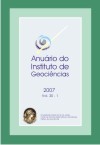Anthropogenic pollution evaluation using patterns of distribution of foraminiferal species from cores of Guanabara bay, RJ
DOI:
https://doi.org/10.11137/2007_1_145-157Abstract
This work presents a study of benthic foraminifera recovered from three cores collected near the Paquetá island, in the Guanabara bay, Rio de Janeiro, southeastern Brazil. The cores have different sizes and were subsampled in centimetric intervals. The recovered benthic foraminiferal assemblages were thoroughly identified, in order to carry out an ecological study towards reconstructing the environmental evolution of the studied area during the recent historical period and assessing the response of the foraminiferal assemblages to the locally occurring natural and/or anthropogenic impacts. The microfaunal distribution results were correlated with the sedimentological and TOC (Total Organic Carbon) data to understand the environmental trends and evaluate the varying patterns of human-related pollution in the area. 14C isotopic date was taken at the bottom of one core, to help for the local sediment accumulation rates. Species diversity values were low in all samples, whereas the TOC values were commonly high, increasing dramatically upwards across the cores. The dominant species in that area of the Guanabara bay were Ammonia tepida, Elphidium spp. and Buliminella elegantissima. Patterns of the distributions of these species confirm the influence of the anthropogenic pollution toward the top of the cores.Downloads
Download data is not yet available.
Downloads
Published
2007-01-01
How to Cite
Figueira, B. O., Vilela, C. G. and Baptista Neto, J. A. (2007) “Anthropogenic pollution evaluation using patterns of distribution of foraminiferal species from cores of Guanabara bay, RJ”, Anuário do Instituto de Geociências. Rio de Janeiro, BR, 30(1), pp. 145–157. doi: 10.11137/2007_1_145-157.
Issue
Section
Article
License
This journal is licensed under a Creative Commons — Attribution 4.0 International — CC BY 4.0, which permits use, distribution and reproduction in any medium, provided the original work is properly cited.















